 |
 |
 |
 News Around the Republic of Mexico | December 2005 News Around the Republic of Mexico | December 2005  
Into the Santa Swirl
 Reed Johnson - LATimes Reed Johnson - LATimes

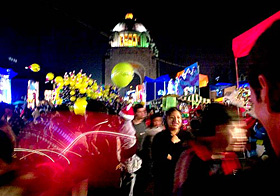
| | Mexico City's Revolution monument overlooks crowds attending the annual Christmas fair, previously held at the Alameda park. | 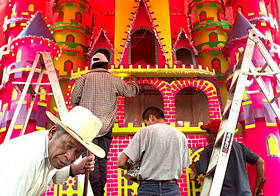
| | Alfredo Reyes helps prepare a Santa scene in hopes of attracting celebrating families. Some vendors say attendance has fallen off at the Revolution monument location. | 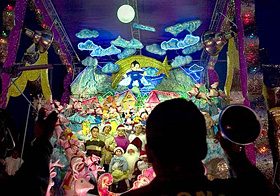
| | A bell ringing worker tries to steer the Sandoval children's attention toward the camera for their holdiay photo. | 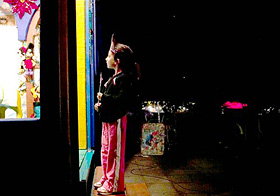
| | Adele Rofi, 6, waits patiently for her turn to be photographed at one of the Christmas fair's 42 Santa Claus scenes. | 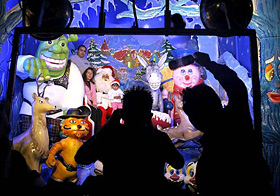
| | Shrek dwarfs a family being coaxed into smiles, despite their close proximity to Santa Claus.
(Sarah Meghan Lee / For The Times) | 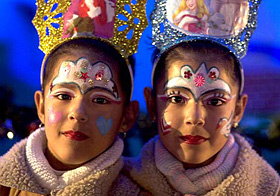
| | Festive six year-old twins, Michela (left) and Leslie Gomez Martinez, come by their holiday glow with face paint. | 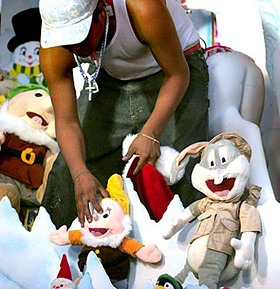
| | Jose Javier Mondoza Morales covers his Santa scene with stuffed animals in between customers for photographs with Santa at the annual Christmas fair in Mexico City on December 18, 2005. | 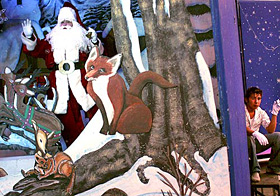
| Marcos Hernandez Paniagua takes a smoke break as his Santa, Adrian Hernandez Martinez tries to wave in new customers for photos with Santa Claus in their night, forest Santa Claus scene, at the Christmas fair at the revolution monument in Mexico City on December 17, 2005.
(Photos: Sarah Meghan Lee/LATimes) |
Mexico City - The Santa Clauses, all 42 of them, were waving, dancing and shaking their fake-o bellies. Hip-hop and ranchera blasted from a half-dozen loudspeakers. Vendors shilled, children shrieked and the twilight sky was tinged with pink cotton candy wisps and the tantalizing scent of tacos al pastor.

It was beginning to feel a lot like Christmas at the Plaza de la Revolucion.

But a touch of melancholy hung in the air as Sergio Alvarán surveyed the annual gathering of Santa Clauses that draws thousands of families to the city center to have their photos taken. Ever since last year, Alvarán said, when the event switched locations from the stately old Alameda Central park to the gritty memorial plaza a few blocks away, things just haven't been the same. "The people don't know that we're here," complained Alvarán, whose family has operated a Santa-themed photo stall for 30 years. "The people don't come here."

These are strange times for the yearly yuletide spectacle known as Santa Clos y los Reyes Magos, or Santa Claus and the Magi. One of the oldest, most cherished activities in this frenzied capital's jam-packed holiday calendar, it's part of a monthlong celebration here of the Christian savior's birth.

In contrast to the United States, where the winter holidays often seem to whisk by in a blur, Mexico, which is 90% Roman Catholic, indulges in a weekslong binge of worshipping, eating, partying and gift-giving. The festivities begin on the Virgin of Guadalupe Feast Day (Dec. 12), soldier on with the pre-Christmas las posadas processions that reenact the holy family's search for shelter, and stagger to a close on Three Kings Day (Jan. 6).

Non-Mexicans unused to such ritualistic fervor may have trouble deciding whether the Santa Clos y los Reyes Magos convocation — which runs from the second week of December through Three Kings Day — is an enchanting tradition, a nightmare vision of holiday commercialism run amok, or both. Like much else in contemporary Latin American popular culture, it's an attempt to preserve a quirky home-grown heritage while accommodating a more generic, mass-produced global culture.

Along both sides of the massive plaza, crowds numbering in the thousands browse two solid rows of photo backdrops filled with beckoning Santas eager to claim their business. These escenarios are humble but sturdy contraptions built of wood and plastic blue tarpaulins lashed together with ropes. Some backdrops are relatively subdued affairs, studded with wooden cutouts of cutesy animals and snow-dusted trees.

But the majority are wild confabulations of twee Alpine or ersatz polar landscapes, decked out with all manner of Hollywood kitsch and tricked up with whirling lights and piped-in music.

Many backdrops sport mismatched menageries of glazed earthenware statues modeled on popular cartoon characters. One may spotlight Mickey Mouse and Goofy alongside a bobble-head reindeer. Another will star SpongeBob SquarePants or a leering, Santa Claus-suited Shrek that, in garish light, looks like the result of a botched genetic experiment involving the pre-redemption Grinch and the Incredible Hulk. One of this year's displays threw in Jiminy Cricket, Shrek, Spiderman and, for good measure, E.T.

Besides the dozens of Santa Clos photo stages, the plaza contains 83 mechanical rides, foosball tables, games of chance and makeshift stands where you can get your face painted or buy a Santa cap or a lucha libre (pro wrestling) mask. Practically anything edible, from corn on the cob slathered in mayonnaise, hamburguesas and traditional pozole stew to piña coladas, can be purchased for a few pesos. It is mostly the city's working classes who congregate here, and some vendors count on their Santa Clos sales to help see them through the tough winter months.

"We are poor here in Mexico," said María Emilia Menéndez Corona, 79, who schleps to the plaza every day by subway from her home in Tlaxcala, 1 1/2 hours away, hauling three sacks of dolls, princess headbands and hand-carved wooden canes that she makes and sells. "We don't have factories to work in. For that reason, we make all these things ... to bring here to sell in Mexico City."

For generations, the various Santa Closes and their cohorts set up camp in the Alameda Central, one of the city's principal gathering points and tourist attractions. Then, in 1985, the streets along the Alameda were devastated by the 8.1-magnitude earthquake that struck Mexico City, killing an estimated 10,000 people. For years afterward the area was badly run down.

But now the Alameda district is being rebuilt with fancy new or refurbished hotels and upscale stores. Like other parts of the capital, it's experiencing a wave of gentrification that's replacing faded Spanish-colonial style structures with concrete towers and trendy lofts. The city's business and political elites apparently feel that noisy, trash-strewing crowds don't fit its chic image, a number of photo stage operators said. So beginning last year the Santa-themed photo booths were relocated to the Plaza de la Revoluçion, named for the hulking Art Deco monument that towers over it. Many Mexicans mourn the change, including some of the Santas.

"It was very different, because more people came" in the past, said Armando González Martínez, a 17-year-old window washer from the suburb of Ecatepec who moonlights as Santa during holiday season to earn extra grocery money. "A little bit of the tradition, it's been lost, going from there to here," said a 23-year-old costumed participant who gave his name only as Santa.

Yet even with the new venue, tens of thousands of people are expected to attend this year's gathering, with the largest crowds anticipated on Christmas and New Year's days. "We visit it every year, so the tradition isn't lost," said Israel Cortés and his wife, María de los Angeles, while strolling the plaza with their 23-month-old daughter, Emilia. The family had commuted nearly two hours by subway from their home. "In the United States there are different traditions, no?" Cortés continued. "But, well, Mexico is always going to be Mexico, and we never change for anything."

Photo stage operators must apply for special city permits. For most, it's as much a family labor of love as a money-making venture. Typically they charge about 50 pesos (around $5) for a family photo with Santa Clos.

Many operators say they start working on their stages as early as September or October, and the most ambitious among them try to change decorations every year. "The more well-built, the more beautiful, and the more beautiful the more they [customers] like it," said Arturo Velasco, 18, who estimates his family has been running a photo stage for "60 or 70 years."

Fortunately, the families who flock to the plaza aren't too finicky about thematic or decorative consistency. For children the big question is how to choose one Santa from so many others? Adele Rofi, 4 1/2, picked a backdrop graced with reindeer and "Sesame Street" plush toys, she said, "for the colors."

In the end, it's a mystery why some operators succeed while others struggle to attract customers.

One of the most popular photo stages this year features a "rock band" of costumed actors: a guitar-playing leopard, bear saxophonist and bunny rabbit bass player, lip-syncing along to "La Bamba." The Santa Clos attached to this group, as it happens, is deaf.

But that's not necessarily a drawback. Because, unlike some U.S. shopping-mall Santas, the Santas at the Plaza de la Revoluçion don't hand out presents. They don't sit listening to children recite rambling gift lists, while their parents stand by egging them on. Instead they just wave, smile and pose for photos. For a few moments, they may even help the people of this poor and troubled country forget their difficulties.

"It's not going well in the world. Many problems, many wars, many deaths," said Antonio Obrego López, 46, who worked as a Santa for decades and now helps tend a photo stage. "It's beautiful, Christmas, because many years ago the world came together for the Christ child. It brought happiness to all the world. But day upon day, we don't do right." | 
 | |
 |



